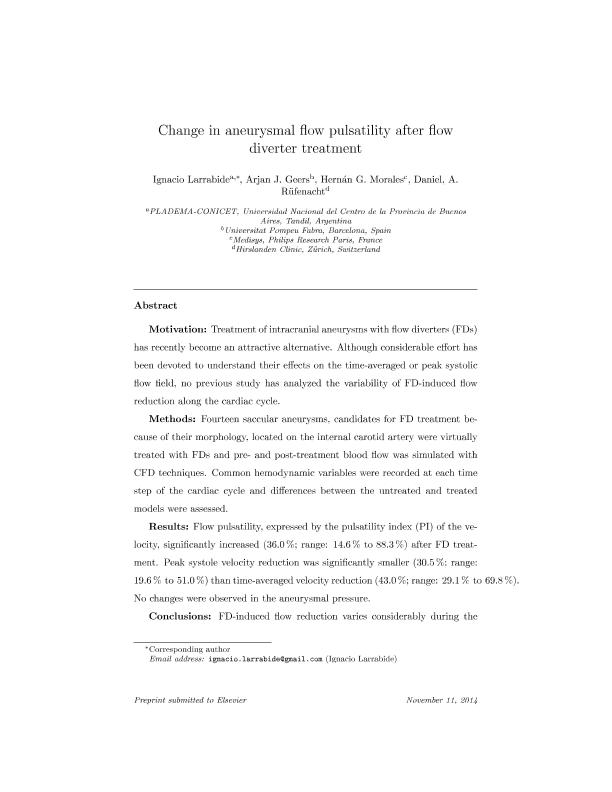Mostrar el registro sencillo del ítem
dc.contributor.author
Larrabide, Ignacio

dc.contributor.author
Geers, Arjan J.
dc.contributor.author
Morales; Hernán G.
dc.contributor.author
Bijlenga, Philippe
dc.contributor.author
Rufenacht, Daniel A.
dc.date.available
2018-01-15T18:39:25Z
dc.date.issued
2015-01
dc.identifier.citation
Rufenacht, Daniel A.; Bijlenga, Philippe; Larrabide, Ignacio; Morales; Hernán G.; Geers, Arjan J.; Change in aneurysmal flow pulsatility after flow diverter treatment; Elsevier; Computerized Medical Imaging and Graphics; 50; 1-2015; 2-8
dc.identifier.issn
0895-6111
dc.identifier.uri
http://hdl.handle.net/11336/33280
dc.description.abstract
Motivation: Treatment of intracranial aneurysms with flow diverters (FDs) has recently become an attractive alternative. Although considerable effort has been devoted to understand their effects on the time-averaged or peak systolic flow field, no previous study has analyzed the variability of FD-induced flow reduction along the cardiac cycle. Methods: Fourteen saccular aneurysms, candidates for FD treatment because of their morphology, located on the internal carotid artery were virtually treated with FDs and pre- and post-treatment blood flow was simulated with CFD techniques. Common hemodynamic variables were recorded at each time step of the cardiac cycle and differences between the untreated and treated models were assessed. Results: Flow pulsatility, expressed by the pulsatility index (PI) of the velocity, significantly increased (36.0%; range: 14.6–88.3%) after FD treatment. Peak systole velocity reduction was significantly smaller (30.5%; range: 19.6–51.0%) than time-averaged velocity reduction (43.0%; range: 29.1–69.8%). No changes were observed in the aneurysmal pressure. Conclusions: FD-induced flow reduction varies considerably during the cardiac cycle. FD treatment significantly increased the flow pulsatility in the aneurysm.
dc.format
application/pdf
dc.language.iso
eng
dc.publisher
Elsevier

dc.rights
info:eu-repo/semantics/openAccess
dc.rights.uri
https://creativecommons.org/licenses/by-nc-nd/2.5/ar/
dc.subject
Aneurysms
dc.subject
Transient Flow Simulations
dc.subject
Flow Diverter
dc.subject.classification
Ingeniería de Sistemas y Comunicaciones

dc.subject.classification
Ingeniería Eléctrica, Ingeniería Electrónica e Ingeniería de la Información

dc.subject.classification
INGENIERÍAS Y TECNOLOGÍAS

dc.title
Change in aneurysmal flow pulsatility after flow diverter treatment
dc.type
info:eu-repo/semantics/article
dc.type
info:ar-repo/semantics/artículo
dc.type
info:eu-repo/semantics/publishedVersion
dc.date.updated
2016-11-23T19:55:34Z
dc.journal.volume
50
dc.journal.pagination
2-8
dc.journal.pais
Países Bajos

dc.journal.ciudad
Amsterdam
dc.description.fil
Fil: Larrabide, Ignacio. Universidad Nacional del Centro de la Provincia de Buenos Aires. Facultad de Ciencias Exactas. Grupo de Plasmas Densos Magnetizados. Provincia de Buenos Aires. Gobernación. Comision de Investigaciones Científicas. Grupo de Plasmas Densos Magnetizados; Argentina. Consejo Nacional de Investigaciones Científicas y Técnicas; Argentina
dc.description.fil
Fil: Geers, Arjan J.. Universitat Pompeu Fabra; España
dc.description.fil
Fil: Morales; Hernán G.. Medisys; Francia
dc.description.fil
Fil: Bijlenga, Philippe. Universidad de Ginebra; Suiza
dc.description.fil
Fil: Rufenacht, Daniel A.. Hirslanden Clinic; Suiza
dc.journal.title
Computerized Medical Imaging and Graphics

dc.relation.alternativeid
info:eu-repo/semantics/altIdentifier/doi/http://dx.doi.org/10.1016/j.compmedimag.2015.01.008
dc.relation.alternativeid
info:eu-repo/semantics/altIdentifier/url/http://www.sciencedirect.com/science/article/pii/S0895611115000105
Archivos asociados
